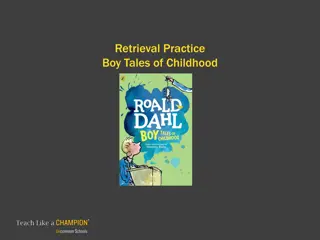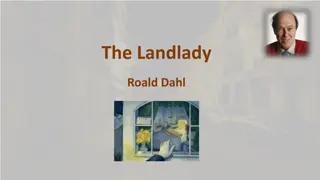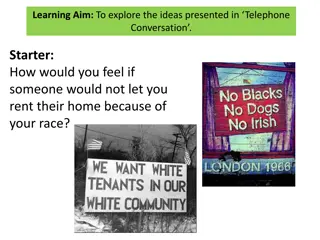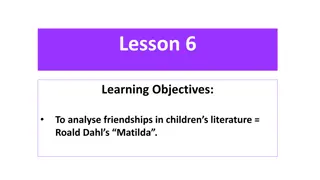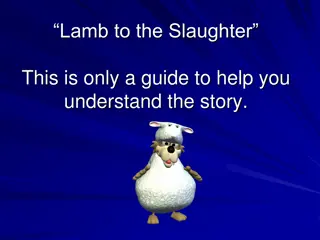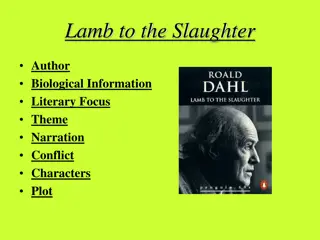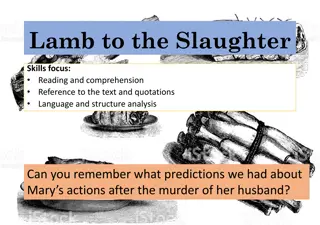Analyzing "The Landlady" by Roald Dahl
The analysis of "The Landlady" by Roald Dahl delves into key elements such as plot, setting, point of view, characters, theme, and genre. The story portrays how appearances can be deceiving as a seemingly harmless landlady turns out to be a sinister character. Through a third-person limited omniscient viewpoint, the suspenseful narrative unfolds in a cozy yet eerie bed and breakfast setting in Bath. The static protagonist, Billy, and round antagonist, the landlady, contribute to the chilling theme of deception. Ultimately, the story exemplifies a mystery genre with a compelling plot that keeps readers engaged.
Download Presentation

Please find below an Image/Link to download the presentation.
The content on the website is provided AS IS for your information and personal use only. It may not be sold, licensed, or shared on other websites without obtaining consent from the author.If you encounter any issues during the download, it is possible that the publisher has removed the file from their server.
You are allowed to download the files provided on this website for personal or commercial use, subject to the condition that they are used lawfully. All files are the property of their respective owners.
The content on the website is provided AS IS for your information and personal use only. It may not be sold, licensed, or shared on other websites without obtaining consent from the author.
E N D
Presentation Transcript
Prose Terminology With The Landlady by Roald Dahl
Plot The plot is the basis of a story; the events that take place. The plot of The Landlady fits together well without missing any components, making the story read well without having gaps.
Setting The setting is where the story takes place. The physical setting of The Landlady is a cozy, comfortable bed and breakfast, in the city of Bath at night. However, the emotional setting is eerie, off-putting, suspenseful, and odd. The emotional setting conflicting with the physical setting gives the story an interesting effect crucial to the suspenseful nature of the story. It underlines the idea that appearances can be deceiving.
Point of View The Landlady is written in Third Person Limited Omniscient: The characters are referred to as he or she, and the reader only knows what Billy is thinking. Knowing that Billy is completely unaware of the danger he is in and not knowing the motives of the Landlady makes the story more suspenseful.
Characters Billy is the protagonist of the story, and is a static, unchanging character. The landlady is the main antagonist of the story. She is a round character with several sides to her personality. The landlady being a round character makes her more frightening because it makes the possibility of a sweet old lady being a killer seem more real. Billy being a static character keeps him from realizing he is in danger. He stays around for the landlady to kill him instead of running away.
Theme is This is the message of the story. The theme of The Landlady is Appearances can be deceiving The story is about a non-threatening looking old woman running a bed and breakfast, who is killing and stuffing her guests. Had the landlady looked like the stereotypical image of a killer it would be a different story entirely. Theme
Genre The Landlady is an example of a mystery story; one where the suspense is the drive of story. At the ending of the story, it is implied through all the odd details that Billy was poisoned, killed, and stuffed by the landlady, and that he was the landlady s third victim.
The title is of the story is The Landlady. The story is about the actions of the landlady, told through the eyes of Billy Weaver, her third victim. The story is about how the landlady may have appeared non-threatening but was a deceptive serial killer. The story is all about the non-threatening landlady, not Billy. The title reinforces that. Significance of Title
Foreshadowing Foreshadowing is described as a hint of events to come. A few examples from The Landlady are the lack of coats, the old guestbook, the almond tea, and the stuffed pets. The entirety of the story is foreshadowing the death of Billy using the evidence of the two past murders. The story is suspenseful and without the foreshadowing it would have no underlying meaning. Just a guy staying at a bed and breakfast.
There are three different kinds of irony: Verbal irony, Situational irony, and Dramatic irony. The Landlady is more suspenseful than ironic, but near the beginning of the story Dahl writes, And in one corner he spotted a large parrot in a cage. Animals were usually a good sign in a place like this, Billy told himself (Dahl, 73). This is ironic because the animals are dead and stuffed, just like what is implied to have happened to Billy. They are the opposite of a good sign. Irony











